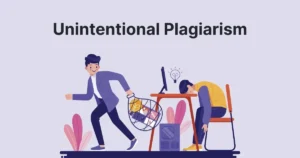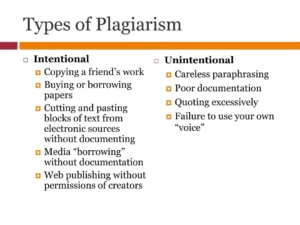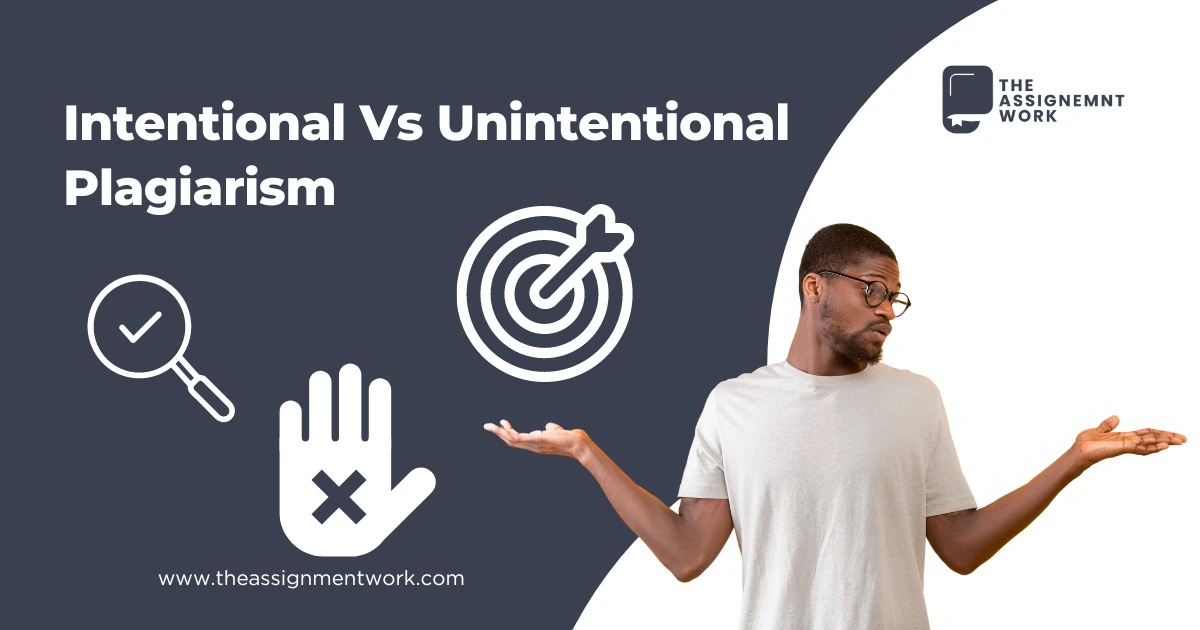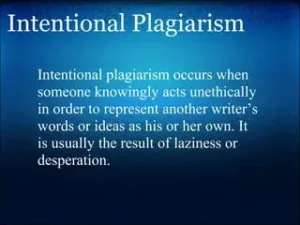Are you unknowingly replicating content from others? Welcome to the realm of Unintentional Plagiarism. On the flip side, Intentional Plagiarism occurs when individuals consciously pass off others’ ideas as their own. Plagiarism, regardless of intent, poses significant ethical dilemmas with far-reaching repercussions in both academic and professional spheres. It encompasses the unauthorized appropriation or presentation of someone else’s work as original. Yet, not all acts of plagiarism are equal. Recognizing the disparities between intentional and unintentional plagiarism is paramount for upholding academic integrity and fostering ethical writing standards.
In this blog, “Intentional and Unintentional Plagiarism” we’ll explore how people sometimes copy others’ work without realizing it, and other times, they do it on purpose. We’ll talk about why this is a big deal in academic and professional settings, and what you can do to make sure you’re being honest and ethical in your writing. Let’s dive in!
Intentional Vs Unintentional Plagiarism
What is Intentional Plagiarism
Intentional plagiarism occurs when an individual knowingly and deliberately presents someone else’s work, ideas, or words as their own without proper attribution. This can involve directly copying passages from sources without citation, purchasing papers online, or submitting work done by others under one’s name.
Intentional Plagiarism Examples
- Copying and pasting text from a website or article without providing proper citation.
- Purchasing or downloading a pre-written essay or paper and submitting it as your own work.
- Paraphrasing someone else’s ideas without acknowledging the original source.
- Using someone else’s photographs, artwork, or graphics without permission or attribution.
- Fabricating data or information and presenting it as factual without acknowledging the source.
- Collaborating with others on an assignment meant to be completed individually and submitting the joint work as your own without disclosure.
Consequences of Intentional Plagiarism
Intentional plagiarism can have severe consequences, including:
- Academic penalties: Students may receive failing grades, be required to redo assignments, or face expulsion from their educational institution.
- Loss of trust and credibility: Intentional plagiarism damages relationships with peers, teachers, and employers, leading to a loss of trust and respect.
- Legal repercussions: Plagiarism can lead to legal action, fines, or lawsuits, especially if it involves copyright infringement.
- Harm to personal integrity: Intentional plagiarism undermines one’s integrity and moral character, impacting self-esteem and self-image.
- Damage to future opportunities: Plagiarism stains academic records and professional reputations, hindering future educational and career prospects.
- Emotional stress and guilt: The fear of being caught, coupled with the guilt of dishonest behavior, can cause significant emotional distress and anxiety.
What is Unintentional Plagiarism

Unintentional plagiarism occurs when a writer inadvertently uses someone else’s work, ideas, or words without proper citation or acknowledgment. This can happen due to a lack of understanding of citation rules, poor paraphrasing skills, or simply forgetting to attribute sources.
Unintentional Plagiarism Examples
- Paraphrasing too closely: When you rewrite something but it still sounds a lot like the original, that’s unintentional plagiarism.
- Forgetting to cite: Sometimes you use someone else’s idea in your work but forget to say where you got it from. That’s unintentional plagiarism.
- Forgetting quotation marks: If you copy something word-for-word but forget to put it in quotation marks, that’s unintentional plagiarism.
- Misunderstanding citation rules: Not knowing when or how to properly cite sources can lead to unintentional plagiarism.
- Mixing up your sources: Accidentally attributing ideas to the wrong person or source can also be unintentional plagiarism.
- Using outdated information: If you use information that was previously published without realizing it’s no longer accurate, that’s unintentional plagiarism.
Consequences of Unintentional Plagiarism
Unintentional plagiarism can have severe consequences, including:
- Academic repercussions: Students who intentionally plagiarize may face failing grades, academic probation, or even expulsion from their educational institution.
- Damage to reputation: Intentional plagiarism can tarnish one’s reputation as a student, scholar, or professional, leading to a loss of trust and credibility among peers, instructors, and employers.
- Legal consequences: Intentional plagiarism, especially if it involves copyright infringement, can result in legal action, fines, and lawsuits.
- Professional setbacks: Plagiarism can hinder career advancement opportunities, damage professional relationships, and limit future employment prospects.
- Personal guilt and stress: The knowledge of having cheated and the fear of being caught can cause significant emotional distress, guilt, and anxiety.
- Long-term impacts: The consequences of intentional plagiarism can have lasting effects on academic and professional endeavors, hindering educational and career goals in the long run.
Also Read:
What is the Difference Between Unintentional and Intentional Plagiarism?

The main contrast between intentional and unintentional plagiarism hinges on the writer’s intent. Unintentional plagiarism occurs when ideas are inadvertently borrowed without citation, often due to unawareness. In contrast, intentional plagiarism entails knowingly omitting citations to pass off others’ work as one’s own, with the aim to deceive. Awareness and ethical writing practices are essential to avoid both types of plagiarism. For Canadian assignment help, understanding these distinctions is crucial to uphold academic integrity and ensure originality in scholarly work.
| Aspect | Unintentional Plagiarism | Intentional Plagiarism |
| Definition | Inadvertently using someone else’s work without proper cit ation or acknowledgment. | Deliberately presenting someone else’s work, ideas, or words as one’s own without proper attribution. |
| Intent | Lack of awareness or understanding of citation rules. | A deliberate attempt to deceive or cheat. |
| Examples | – Inadequate paraphrasing.
– Forgetting to include citations. – Accidental use of someone else’s ideas without attribution. |
– Directly copying passages without citation.
– Submitting work done by others as one’s own. – Purchasing or downloading papers online and claiming authorship. |
| Consequences | Can still result in academic penalties or damage to credibility but often stems from ignorance or carelessness. | This may lead to severe academic penalties, legal consequences, and damage to reputation due to deliberate dishonesty. |
What is the Best Solution to Avoid All Types of Plagiarism?
Prevent plagiarism by citing sources, mastering paraphrasing, keeping records, seeking guidance, and using plagiarism checkers.
- Keep track of all consulted sources during research.
- Master paraphrasing techniques and incorporate personal ideas.
- Always credit the original author with in-text citations and in the reference list.
- Utilize plagiarism checkers before submitting any work.
- Seek guidance from instructors or academic resources regarding citation practices.
On an ending note,
Understanding intentional and unintentional plagiarism is essential for maintaining honesty in writing. Intentional plagiarism involves purposefully copying, while unintentional plagiarism occurs by mistake. Knowing the difference helps writers keep their work fair and honest. Remembering to give credit to others and always being truthful in writing is crucial. To avoid plagiarism allegations, try using a plagiarism checker tool. It ensures your work is original and helps prevent any accusations. By staying honest and utilizing tools like the plagiarism checker, writers can contribute to a culture of ethical scholarship and uphold academic integrity in their work.
So, take proactive steps towards authenticity in your writing and give the Plagiarism Checker Tool a try today!



